
How Accurate Are Utility Markings?
Have you ever seen strange markings on the pavement, sidewalk or dirt around a site that is about to be excavated? Sometimes they look like colored lines, while other times you’ll see bright symbols and/or colored flags dotting a property. These are utility markings. They are placed after a utility locator discovers the general location of a utility.
Without these symbols, utility lines and structures could be damaged or destroyed during excavation. Even worse, people could be harmed or killed while working in construction if they do not know where underground utilities are located. But can you always trust utility locator markings to be accurate? Here’s what you should know about these markings and what tools you can use to find underground utility structures yourself.
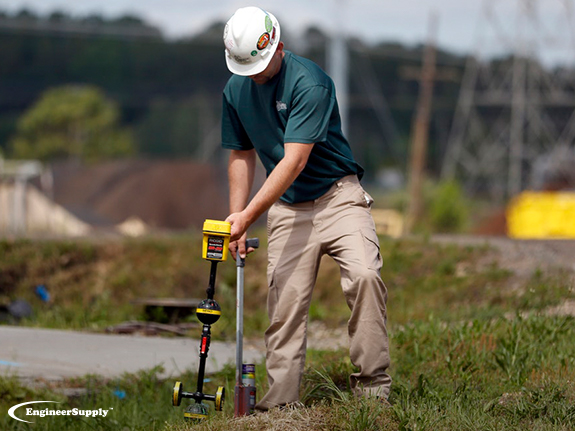
Utility Marking Accuracy
When utilities are properly located and marked, they can generally be found within two feet of the mark (on either side). This means that as a construction worker or homeowner working on a deep dig project, you should maintain at least a 2-foot berth around all markings. If utility markings are not properly located or if they are somehow damaged or removed, the company or person who placed the markings is responsible to pay for any damage caused by their error.
How Are Utilities Located?
There are a variety of materials used in the manufacturing of underground utility lines, so it can be challenging to locate them all. Different methods must be used for different materials. For example, electromagnetic cable locator equipment is used to locate metal cables and pipes, while ground-penetrating radar or other types of pipe locator radiolocation are required to locate concrete or plastic pipes.
Once located, specific color codes must be used to designate what type of utility lies beneath the mark. In the United States, the following colors are used:
- Red: lighting cables, electric power lines, conduit
- Yellow: oil, natural gas, petroleum, steam, other flammable or gaseous material
- Orange: alarm or signal lines, telecommunication cables or conduit
- Blue: drinking water
- Green: Sewers and drain lines
- Pink: Unknown facilities or temporary survey markings
- Purple: reclaimed water, slurry lines and irrigation
- White: proposed excavation routes or limits
These color codes follow the American Public Works Association guidelines.
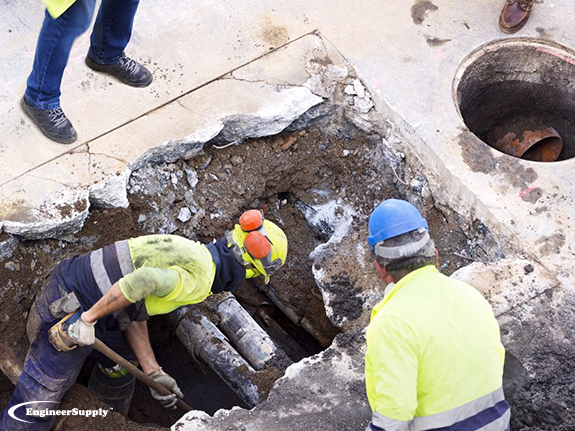
Get the Right Tools
Whether you’re a homeowner getting ready to install a sprinkler system or a contractor building a home, you may want to double-check all utility locations to keep yourself and others safe. From pipe locators to cable locators, you can find the tools you need at Engineer Supply.
Browse our inventory of cable & pipe locators or call us at 800-591-8907 to get started.
Picking the Perfect Pipe and Cable Locator for Your Needs
No matter what type of work you do, you need to have access to the right tools in order to perform to the best of your abilities. Working with subpar equipment not only reflects poorly on you as a professional, it can also lead to some major complications in terms of the readings you are given from your devices. Since accuracy is one of the most important factors in fields like utility marking, you cannot just rest on the assumption that the tools you currently use are enough to help you see continued success.
Knowing which equipment is best for marking utilities and lines is key to your long-term success in the industry. Take time to look over these top options for locators and discover the perfect fit for your needs.
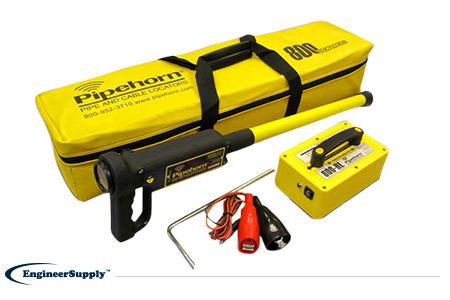
The
Pipehorn 800HL Dual-frequency Pipe & Cable Locator Model MD840 is one of the most powerful
pipe locators on the market. With a frequency of 480kHz, it’s perfect for detecting utility lines and cables that are buried beneath the ground’s surface. Its capability even includes insulated joints, coated iron pipes, and concentric neutrals. The only feature that matches its detection capability is the extreme durability of the receiver wand. It’s watertight and offers a super-fast response for better signals in any and every condition.
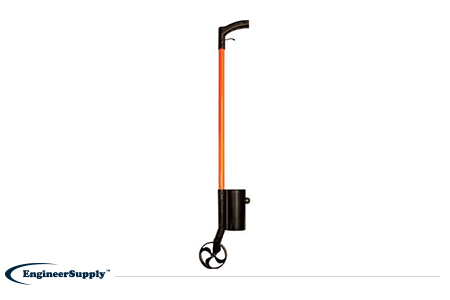
Precision is the name of the game when you’re tasked with paint application. There’s no room for crooked lines or inconsistency. That’s why you need the
Keson Spray as You Walk Paint Applicator PA35. This light but mighty tool features an attachable wheel connected to a marking wand for quick and simple painting on the go. Its sleeve can accommodate any standard aerosol paint can, and the pistol grip lends users an unbeatable efficiency. The east-to-read counter can clock nearly two miles before needing to be reset, too, making it a great tool for assessing distance during long-term painting jobs.
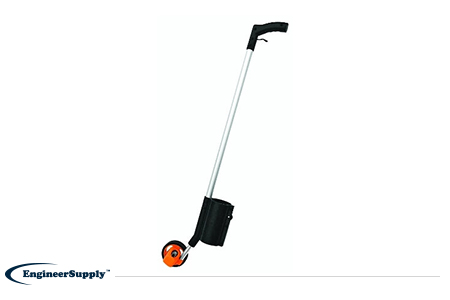
There’s no name above Keson in the paint applicator category. Like the PA35, the
Keson Road Runner Paint Applicator RRPA18 can be used with a
utility locator to measure mileage, apply paint with precision, and maintain consistency along long-term paint jobs. All of these features are due to the tool’s lightweight construction coupled with its easily handled pistol grip. It weighs barely two bounds, so it’s no burden at all for the worker who has to paint all day long. The best part is that it’s an all-in-one tool — anybody with the RRPA18 can measure their marks and paint alone.
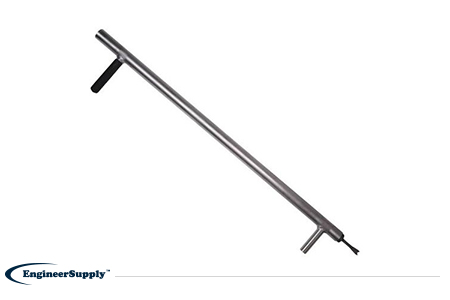
The
Presco Marking Flag Insertion Tool SFP36 is one of the best
utility marking tools in its class. Its design is made from a machined aluminum construction that’s incredibly durable and completely rustproof. It also features padding over the handle to make everyday use more comfortable. If you’re using this tool in conjunction with a
utility locator, you can be confident that you’re marking the right spot every time. The unique dual tip design allows flags to be securely inserted into the ground without any damage or bending. Users can enjoy a foot rest, too, that allows for hole punches with less energy exertion.
When it comes to using the right
utility locator, there are several factors to consider. In order to impress your clients and deliver the best results time after time, you simply need to take a step in the right direction and discover the gear that can help you achieve your goals. Review your options at
Engineer Supply and find the perfect fit for your next job.
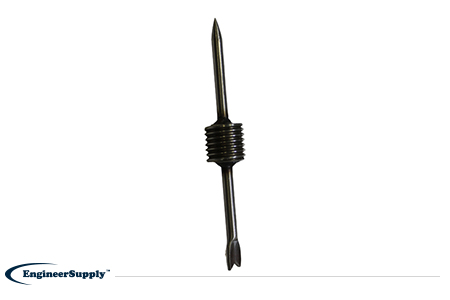
If your Presco Marking Flag Insertion Tool is in need of a replacement tip, you’re in luck. The
Tip PT3 is specially designed for use with the SFP36 and it features the tool’s signature dual tip design. With an overall length of six inches and a tip length of just three inches, it’s small and lightweight enough to easily install in your flag insertion tool and use with
pipe locators, too. Don’t let the size fool you, though — this tip packs a punch!

Frequently Asked Questions
What does a utility locator do?
The purpose of a utility locator is to determine where underground utilities should be placed and where existing utilities are located. This consists of items like telephone, gas and power lines. The people that use them often work for utility, consulting and construction companies.
How do you use a utility locator?
There are 3 modes that you can use to help you locate hidden utilities, conductive mode, Inductive Clamp Mode or Inductive mode.
- The Conductive Mode - Connect directly to the conductor with clips & a ground stake
- The Inductive Clamp Mode - Use a clamp and place it around the conductor
- The Inductive Mode - Set the transmitter or antenna over the conductor
The key is applying the proper frequency since the signals dissipate through the ground. Keeping these things in mind will help you better leverage your utility locator.
What is the best underground utility locator?
The best utility locators are designed to withstand the rigors of tough daily field use and a wide range of environmental conditions. In order to do the job right, it needs to be able to transmit a signal through either conductive or inductive means. The receiver should be portable so you can wave it over the areas you believe the utility to be in.
What is a pipe locator?
A pipe locator uses conductive or inductive methods to find pipes that are hidden with a high level of accuracy & reliability. A conductive pipe locator may be used to apply a signal to a coated metallic pipe at a specific access point which could be a valve or meter. The signal's return path can pass through a ground stake or a building grounding system to get back to the transmitter. Conductive pipe locators may also be used to locate tracer wires buried underground with nonmetallic pipes.
Pipe locators provide a safe and reliable way to check walls, ceilings, floors and underground for hidden pipes prior to renovation, demolition or digging.
What is a pipe cable locator?
A pipe cable locator is a device that uses electromagnetic induction to find underground cables. Technology has advanced to the point where cable and pipe locators are portable, reliable and accurate. Technicians around the world use them to find underground cables and pipes.
Please Wait...
